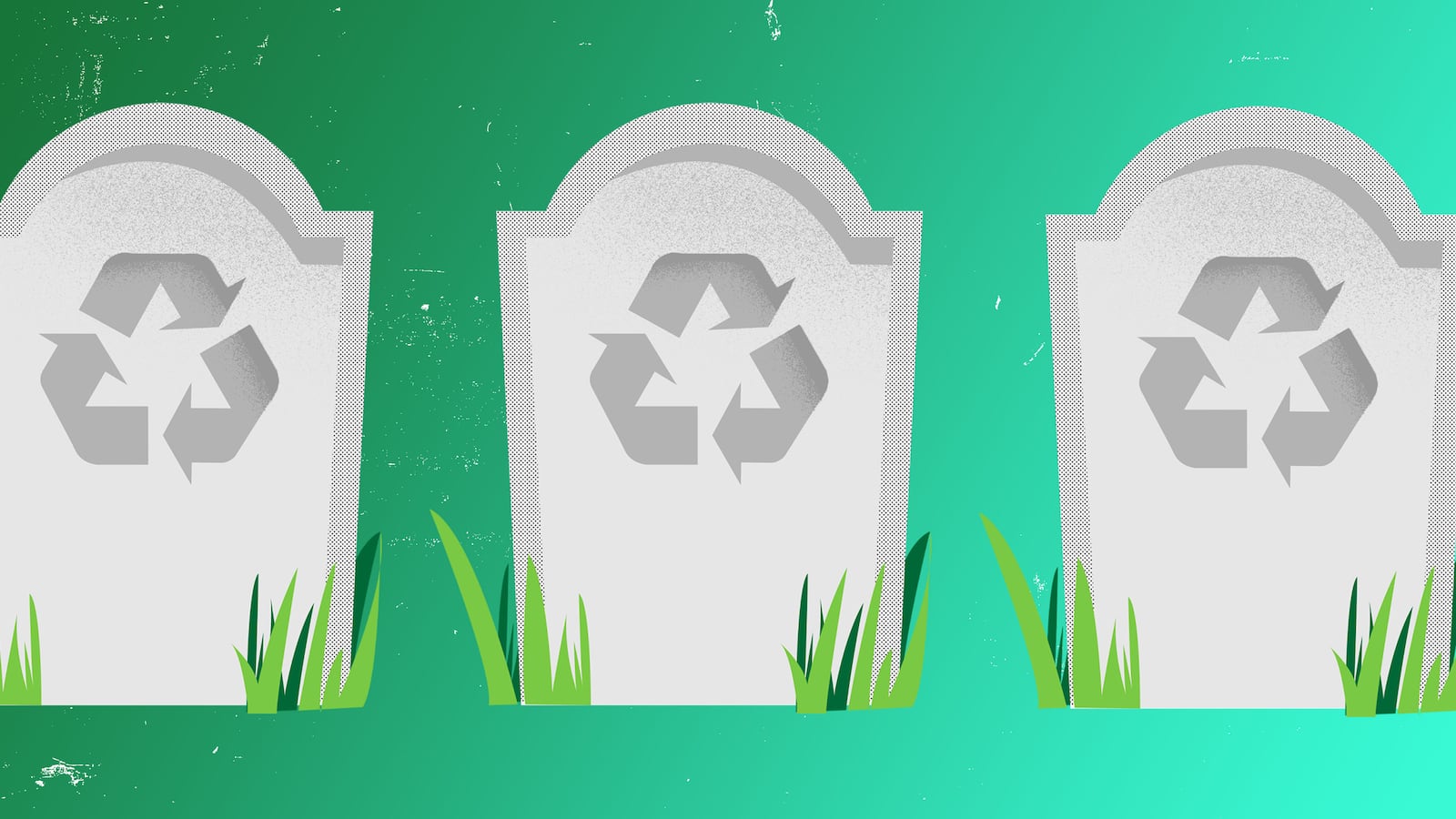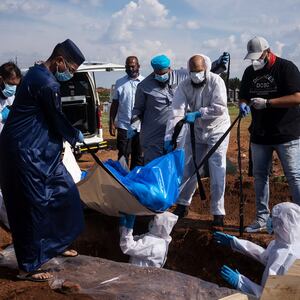The death of Archbishop Desmond Tutu last December made headlines for many reasons, not least because of Tutu’s great reputation as an anti-apartheid advocate and humanitarian. But there was also another reason his death was trending—he requested that his remains be “aquamated” and interred in a simple wooden box at St. George’s Cathedral in Cape Town, South Africa.
Despite the cutting-edge name, aquamation (otherwise known as alkaline hydrolysis) is a fairly simple way to use water, heat, and alkali chemicals to accelerate the decomposition of the body. First used in 1995 to safely manage human remains donated to science, aquamation’s mainstream draw these days is that it produces 90 percent less carbon emissions than flame cremation. A funeral home in Florida first began offering it as a burial service in 2011, and in the past 10 years, advocates of aquamation have been petitioning to make it legal and accessible around the world.
Aquamation is now emerging as one of a number of new end-of-life practices that offer a gentler environmental impact than traditional funeral options. With the realities of climate and ecological collapse nipping aggressively at our heels as we enter our third year of an increasingly tragic global pandemic, the oft-taboo topic of death has rarely been more openly discussed than the present day. Even our deaths have an environmental cost, and the urgency to limit our carbon footprints has begun forcing us to reconsider how we leave our mortal meat suits behind.
Approximately 1.4 million acres of land in the U.S. is used for cemeteries. Bodies are buried using an annual 4 million gallons of embalming fluid made from highly carcinogenic chemicals, including formaldehyde, solvents and disinfectants. Traditional burials may involve caskets built from 150 million board feet of hardwood, and grave liners poured into the ground are made of concrete, plastic, or bronze—far from biodegradable materials.
Flame cremation may not take up the land that traditional burials do, but they inflict their own kind of negative environmental impacts. Cremations, now the choice of funeral for more than half of all Americans, requires burning natural gas at temperatures between 1400 and 1900 degrees Fahrenheit. They produce an estimated 360,000 pounds of carbon dioxide emissions in the U.S. annually.
The Environmental Protection Agency also reports that flame cremation is a “significant source of mercury emissions” due to dental fillings and mercury in blood and tissues, and may have resulted in the release of 1.8 tons of mercury into the environment as of January 2021.
“It’s just waste after waste after waste,” said Ngaio Davis, founder and owner of KORU Grassroots Deathcare, a women-owned death caring practice located in Vancouver. Davis left the traditional funeral industry in late 2013 because of questionable environmental practices, and a growing sense of disconnect from what she once thought of as a community-based practice. “The longer I worked for them, the further away I got from that feeling, that connection with humanity.”
With the funeral industry capitalizing on death to the tune of a few billion dollars, there’s a vested interest in keeping the status quo of expensive, wasteful funeral practices alive. Davis told The Daily Beast she believes conventional funeral services view natural death care options as a “threat to their business model.” The funeral industry, she said, is bolstering bureaucratic regulation that continues to slow down the legalization of environmentally friendly burial options like aquamation.

A mortuary trolley is placed next to the Aquadome machine, a stainless-steel chamber used for aquamation, at the AVBOB Maitland Funeral Parlour in Cape Town, South Africa, January 11, 2022.
Reuters/Shafiek TassiemThis is despite the fact that Dutch researchers have already found aquamation to have the lowest environmental impact of all other burial options. “The easiest way to understand it is that it’s an alternative to burial and cremation,” said Samantha Sieber, vice president of research at Bio-Response Solutions, a company in Indiana that focuses on non-burning technologies. “You still get an urn with ashes, but it doesn’t use any fire. It’s a water based process, and it’s more sustainable.”
Sieber has testified for the regulation and legalization of aquamation for human remains in state Senate hearings across North America. She has contributed to pending legislation in 15 states, and is hopeful that most of them will pass bills to legalize aquamation by the end of the year. She has been lobbying for some of these bills for almost a decade.
While Bio-Response Solutions offers the technology for aquamation, its home state of Indiana has yet to legalize the practice. Interested residents are forced to travel to one of twenty other states where aquamation is approved. “Economically, you would want to keep business in your state, and a lot of people are going out of state—far distances—for aquamation,” Sieber said.
Convincing governing bodies to legalize the practice depends largely on the political demographic of the state. According to Sieber, while liberal states tend to lean in favor of the practice because of the environmental benefits, conservative states require a delicate framing that takes into consideration the potential economic impacts. Despite there being no difference in state infrastructure costs between aquamation and flame cremation, it still remains challenging to convince governing bodies to legalize the practice, particularly when “you’re up to bat against a hundred other issues,” said Sieber.
In British Columbia, Canada, citizens and death care professionals have created the Aquamation BC Coalition to petition the provincial government to allow aquamation as an option. Davis is on the coalition’s board, and said she considers legalization a “no brainer,’ given that over 80 percent of deceased bodies in British Columbia are flame-cremated—one of the highest cremation rates in North America.
Davis feels strongly that aquamation makes even more sense than green burials, another eco-friendly option that foregoes embalming and encourages the use of biodegradable materials. Green burials require the use of land that has been certified for its particular use, which may add to the complexity and cost involved.
“Rather than trying to convince even 40 percent of people to consider green burials,” said Davis, “it seems a wiser decision to say, ‘OK, we’ve got an overwhelmingly high number of people choosing cremation, so why shouldn’t we just offer better, cleaner, greener cremation options, and then everybody has choice?”
Human Composting Takes Center Stage
Aquamation, however, is not even the most radical approach to environmentally-friendly burials. Some people go as far as to simply turn the human body directly into compost—a process technically called natural organic reduction (NOR). The body is placed in a vessel or directly in the ground alongside straw and wood-chips. The remains are allowed to decompose naturally, and in the process releases high amounts of heat that eliminate pathogens, viruses and bacteria. In six to eight weeks, you end up with a usable, nutrient-dense soil that can be used to grow plants and trees.
According to Troy Hottle, a sustainability analyst and advisor to human composting company Recompose, NOR for human remains uses one-eighth of the energy of flame cremation, saving the equivalent of the energy required to power 49,000 homes in the U.S. for one year.
In truth, the process mirrors the composting practices used in a typical backyard garden. But it's no surprise that many people are not so warm to the idea of using human remains to help grow their plants.
After a lengthy campaign by advocates, NOR for human remains was made legal in Washington state in 2019. Colorado and Oregon followed suit in May and June of 2021, respectively. New York and California are not far behind.
Washington-based Herland Forest Natural Burial Cemetery, a registered charity and cooperative community operating since the ’90s, was the first organization to receive a license to permit the use of NOR for human burial in July of 2020. Walt Patrick, president and trustee of Herland Forest, told The Daily Beast: “This is for people who want to become part of nature again, and want to do it in a way that doesn’t harm the environment.”
Patrick believes the biggest obstacle preventing people from making different end-of-life choices such as NOR, is cultural programming. “Seeing is believing,” he said. “The concept that you can ‘go home’ another way, is papered over by the commercialization that is supported and validated by the media.”
And regardless of what people’s preferences are for eco-friendly funerals, “It’s going to take all of the options,” Sieber emphasized. “It’s going to take natural organic reduction, green burial, and even traditional burial, with some things changed.”
Grieving, Redefined
Margaret Verschuur was thrilled when she first heard about green burials. “I had chosen cremation because I wanted my body scattered in the wild places I love, rather than having it own a plot in a cemetery where nature doesn’t flourish,” she told The Daily Beast. “Yet as a gardener, I know how nutrient-rich my body is, and how intense heat destroys most of these nutrients and pollutes the environment.” She was immediately attracted to the notion of a green burial, as “a way for my body to actually contribute to natural growth.”
Over the past two years, Verschuur has worked with her local community on Cortes Island in British Columbia to create a green burial plot adjacent to one of two nearby cemeteries. “I think having natural burial available in our community is having an impact already,” she said. “Rather than a body cremated many miles away, it is buried close to home. I think about three of the recent burials, and realize that if it hadn't been for a natural burial, there likely would have been no service at all, or at least not until after COVID.”
When Cortes Island resident Karen J. (she requested her last name not be revealed due to privacy concerns surrounding her family) received news of her son’s death in April 2021, she called Verschuur, who was just wrapping up the final paperwork on approving the green burial plot. “Originally, I thought I was going to have him cremated,” she told The Daily Beast. “But then I had this nightmare, and I saw this huge industrial gas furnace going and it just put me back to the Holocaust, and I felt that ‘No, I can’t do the cremation.’ I was interested in natural burial because the person is buried in natural materials, whether it's a wooden coffin, or in my son's case, shrouded in cotton sheets. It's all about decomposing naturally and restoring it to the earth.”
Karen became directly involved in the preparation of her son’s body, an option that most people aren’t aware of. “The process of washing my son and wrapping him and then lowering him into the grave, and then shoveling the dirt on and filling up the hole; it was so very therapeutic. I am so grateful to have been able to do that preparation with my son. That was one of the biggest factors in I think healing in the grieving process. Because it was one final loving act that as a mother, I could do for my son.”
Verschuur echoed those same sentiments, and is looking forward to her own burial being one that can leave a positive impact, even if it’s modest. “I have taken so much from this Earth. When I die, I want my final act to be one where I give back.”


